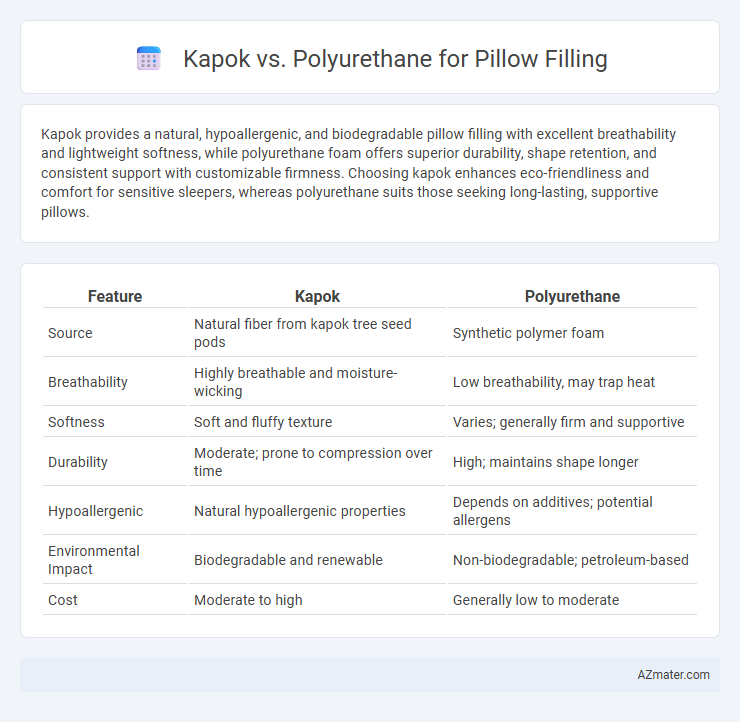Kapok provides a natural, hypoallergenic, and biodegradable pillow filling with excellent breathability and lightweight softness, while polyurethane foam offers superior durability, shape retention, and consistent support with customizable firmness. Choosing kapok enhances eco-friendliness and comfort for sensitive sleepers, whereas polyurethane suits those seeking long-lasting, supportive pillows.
Table of Comparison
| Feature | Kapok | Polyurethane |
|---|---|---|
| Source | Natural fiber from kapok tree seed pods | Synthetic polymer foam |
| Breathability | Highly breathable and moisture-wicking | Low breathability, may trap heat |
| Softness | Soft and fluffy texture | Varies; generally firm and supportive |
| Durability | Moderate; prone to compression over time | High; maintains shape longer |
| Hypoallergenic | Natural hypoallergenic properties | Depends on additives; potential allergens |
| Environmental Impact | Biodegradable and renewable | Non-biodegradable; petroleum-based |
| Cost | Moderate to high | Generally low to moderate |
Introduction to Pillow Filling Materials
Kapok and polyurethane represent two distinct types of pillow filling materials, each offering unique comfort and durability characteristics. Kapok, a natural fiber derived from the seed pods of the kapok tree, provides a lightweight, hypoallergenic, and eco-friendly alternative with good breathability. Polyurethane foam, especially memory foam variants, offer superior support and durability but may retain heat and contain synthetic chemicals, making them less suitable for those seeking natural or allergen-free options.
What is Kapok?
Kapok is a natural fiber harvested from the seed pods of the kapok tree, known for its lightweight, hypoallergenic, and biodegradable properties. It offers excellent breathability and moisture resistance, making it an eco-friendly alternative to synthetic fills like polyurethane foam. Unlike polyurethane, kapok provides a soft, resilient cushioning without retaining heat, enhancing comfort for pillow users seeking sustainable bedding options.
What is Polyurethane?
Polyurethane is a synthetic polymer widely used in pillow filling for its durability, resilience, and ability to retain shape over time. It is made from a chemical reaction involving polyols and diisocyanates, resulting in flexible foam that offers excellent support and cushioning. Unlike natural kapok fibers, polyurethane foam provides consistent firmness and is often preferred for hypoallergenic and low-maintenance bedding solutions.
Comfort and Support: Kapok vs Polyurethane
Kapok pillow filling offers a naturally soft, fluffy texture that provides gentle comfort and conforms well to the head and neck, making it ideal for those who prefer a plush feel. Polyurethane foam, especially memory foam varieties, delivers firmer support by evenly distributing weight and maintaining shape to reduce pressure points, benefiting individuals with neck or back pain. While kapok excels in breathability and natural cushioning, polyurethane is superior for structured support and durability over time.
Breathability and Temperature Regulation
Kapok fibers are naturally hollow, providing superior breathability and moisture-wicking properties that promote cooler sleep by allowing air to circulate freely within the pillow. Polyurethane foam, especially memory foam variants, tends to retain heat and restrict airflow, which can lead to warmer sleeping conditions and reduced temperature regulation. Choosing kapok pillow filling enhances ventilation and helps maintain a comfortable, cool sleeping environment compared to polyurethane options.
Hypoallergenic Properties Compared
Kapok fiber is naturally hypoallergenic, resistant to dust mites, mold, and mildew, making it an excellent choice for allergy sufferers and individuals with sensitive skin. Polyurethane foam, while commonly used, can emit volatile organic compounds (VOCs) and may harbor dust mites unless treated with hypoallergenic chemicals. Choosing kapok over polyurethane enhances pillow hygiene and reduces allergic reactions due to its organic, breathable, and antimicrobial properties.
Durability and Longevity
Kapok pillows offer natural resilience but tend to compress and lose loft over time, reducing durability compared to polyurethane foam. Polyurethane filling, especially high-density memory foam, maintains shape and support for years, providing superior longevity in pillow performance. The synthetic nature of polyurethane also resists moisture and allergens better, extending the pillow's usable lifespan beyond that of kapok.
Environmental Impact and Sustainability
Kapok pillow filling is derived from the seed fibers of the kapok tree, making it a biodegradable, renewable, and eco-friendly option that requires minimal chemical processing. In contrast, polyurethane foam is a synthetic material produced from petrochemicals, contributing to non-biodegradability and significant environmental pollution during manufacturing and disposal. Choosing kapok fillings supports sustainable forestry practices and reduces carbon footprint, whereas polyurethane relies on fossil fuels and results in increased landfill waste.
Maintenance and Care Requirements
Kapok pillow filling requires minimal maintenance due to its natural, hypoallergenic properties and resistance to dust mites, needing only occasional airing to maintain freshness. Polyurethane foam pillows demand more frequent cleaning since they can absorb moisture, oils, and allergens, often requiring spot cleaning or use of protective covers to extend their lifespan. Regularly fluffing kapok pillows helps maintain loft, while polyurethane pillows may lose shape over time and need replacement or reshaping to ensure proper support.
Choosing the Right Filling: Kapok or Polyurethane?
Kapok offers a natural, hypoallergenic, and biodegradable option with excellent breathability and lightweight softness, ideal for eco-conscious sleepers seeking organic comfort in pillow filling. Polyurethane foam, including memory foam, provides superior support and durability, conforming to the head and neck while retaining shape over time, making it suitable for those needing orthopedic support. Selecting between kapok and polyurethane depends on individual preferences for natural materials versus supportive structure and longevity in pillow performance.

Infographic: Kapok vs Polyurethane for Pillow filling
 azmater.com
azmater.com